Amon Duul
Gli Amon Duul II furono forse i piu` "teutonici" dei grandi complessi tedesci degli anni '70. Il loro sound era "gotico" nel senso piu` autentico (e meno spettacolare) del termine, non per il gusto di evocare atmosfere terrificanti ma per la natura stessa delle loro radici culturali. Al picco della loro espressivita`, gli Amon Duul II sposarono quel senso del gotico teutonico con gli eccessi musicali della psichedelia.
Il loro sound si evolse rapidamente, rivelando presto l'influenza dell'acid-rock californiano, ma orrendamente deformato da un linguaggio verbale oltraggioso e blasfemo e da un linguaggio sonoro feroce e orgiastico. La strumentazione estesa e l'improvvisazione si sposavano a cadenze da cavalcata satanica, conferendo ai brani un aspetto minaccioso da grandguignol.
Gli Amon Duul 0 erano un trio di free-jazz formato nel 1966 a Monaco dal chitarrista e violinista Chris Karrer, dal bassista Lothar Meid e dal batterista Christian Burchard (che avrebbe formato gli Embryo). Gli Amon Duul (senza lo zero) furono invece l'espressione musicale di una comune di artisti e di attivisti politici, a cui apparteneva anche Karrer.
I primi Amon Duul erano forse il gruppo piu` politicizzato del Sessantotto tedesco. Una session di ben 48 ore, improvvisata alla fine del 1968, forni` materiale per tre album: Psychedelic Underground (Metronome, 1969), riedito come This Is, Collapsing (Metronome, 1970) e Disaster (BASF, 1971). oltre al bootleg Experimente. Il primo album e` l'unico che il gruppo autorizzo`. Contiene jam tribali e caotiche che si ispirano a un concetto di musica amatoriale teorizzato dal leader Ulrich Leopold. Paradieswaerts (Ohr, 1970), invece, contiene soltanto tre brani (compreso un duetto per chitarra e batteria, Snow Your Thurst and Sun Your Open Mouth) e sembra suonato da un altro complesso, tanto e` diverso il sound appunto "paradisiaco" dalle orge anarchiche degli altri album.
Alla fine del 1968 Karrer decise di lasciare la comune e formare un vero complesso rock. Lo seguirono la cantante Renate Knaup-Kroaetenschwanz, il chitarrista Johannes Weinzierl, il batterista Peter Leopold e l'organista Falk Rogner. Il complesso assunse il nome Amon Duul II, per differenziarsi dalle due entita` precedenti di Karrer.
L’album di esordio di Amon Duul II, Phallus Dei (Liberty, 1969), ha visto incrementare il gruppo di circa sette otto elementi, assorbendo il bassista Dave Anderson ed il batterista Dieter Serfas. L’album, perlopiù solo strumentale, segna un nuovo standard per la "black Music", e rimane come uno dei più infernali baccanali della storia della musica rock. La lunga suite di Phallus Dei (20 minuti) inizia con sonorità elettroniche smorzate e dissonanze tipo Stockhausen, mentre si ode il chiacchiericcio del cantante in un viaggio lisergico. Lentamente, ma in modo costante il ritmo sale e la band si lancia in un frenetico jam blues sullo stile Cream. La voce sembra urlare da lontano, come se cavalcasse questo apocalittico crescendo di musica. Improvvisamente la musica si ferma. Un violento riff di violini che sembrano uscire fuori da un ballo di piazza riesuma i baccanali che velocemente si tuffano in un'orgia di percussioni africane. Finalmente questo selvaggio, caotico sabbah si coagula in una marcia solenne, e la voce sembra gridare formule terribili che echeggiano nelle caverne dell’inferno. Il violino suona come se esso stesso chiamasse dall’inferno, e guida la folla dei dannati verso il fuoco eterno.
La massa "nera" dell'album è caratterizzata sull'altro lato dell’LP, da un ballo di streghe in Kanaan (che ha un ritmo simile al vorticare di un derviscio) e gli incontrollabili pow-wow esortanti di Luzifer's Ghilom (rappresentando un ritmo che varia dallo stile Jethro Tull alle dinamiche convolute di Van Der Graaf Generator). Il ritmo zingaresco e le urla sataniche guidano invece Dem Guten Schoenen Wahren (con un lento suono di un mellotron che apre il brano) nascondono i primi suggerimenti di spiritualità (i.e., la melodia del poema epico che levita sul rumore).
L'album intero è giocato in un tono naïf e casuale che impallidisce comparato con l'austero e calcolato approccio del rock progressivo britannico. Ma questa affermazione è smentita in appello: questa è una comune di hippy che offrono il più spontaneo approccio di rock jamming.
Gli eccessi macabri e la estrema profusione strumentale dei primi giorni trovarono nuovo significato col doppio LP Yeti (1970), un altro capolavoro caratterizzato per la sua l'intensità Wagneriana.
L'album è molto più professionale (sia per la produzione che per la realizzazione musicale) del primo. Il pezzo trainante è Yeti, un jam improvvisato di 18 minuti. D'altra parte il concettuale, pilastro strutturale dell'album è Soap Shop Rock, una suite veloce i cui quattro movimenti mescolano elementi di hard-rock, chitarra raga, toni medio-orientali, canti lirici, e le solite improvvisazioni di violino gitano. Il bruciante riff Jethro Tull-esco in Archangels Thunderbird (basato su un inno sacro) aggiunge un'altra dimensione alla loro tecnica di battaglia. La morbida, atmosfera soprannaturale di Eye-Shaking King probabilmente rappresenta la loro vetta nel genere gothic. In Yeti Talks To Yogi (6 minuti) sembra di essere tornati al jamming caotico e cacofonico di Phallus Dei. Sandoz In The Rain (nove minuti) è ancora più chiassoso e trasporta il loro inferno teutonico nel reame del ronzante cosmic rock. Niente è meno eccitante della breve Cerberus, un jam strumentale acustico/esotico.
L'album copre un ampio spettro stilistico e reinventa il rock progressivo come un genere meno intelligente e più aperto. La musica psichedelica e la dimensione esotica coesistono armoniosamente. La musica trova un equilibrio tra rumore e armonia, hard rock e soft rock, lo stile gothic ed il pastorale. Il suono sovrumano di Phallus Dei è divenuto "umano."
Il terzo album, Tanz Der Lemminge (1971), è un lavoro più sofisticato, ma non meno terribile (e monumentale). La già folta line up del gruppo (Chris Karrer chitarra e violino, John Weinzierl chitarra, Lothar Meid basso, Falk Rogner tastiere elettroniche, Peter Leopold batteria) è completata con Alois Gromer (sitar) ed il tastierista di jazz americano Jimmy Jackson (suonando un organo con sonorità da chiesa che diverrà il marchio di fabbrica del loro suono). Le composizioni chiave dell'album sono suites che espandono il concetto di Phallus Dei. Loro non sono né dark né apocalittici, anche se mantengono un’aria di ansia e perversione. La produzione è più pulita, più crespa e agile. Il loro suono è lineare e coesivo. Le canzoni non sono improvvisate affatto: sono strutture razionali. Invece di puntare ossessivamente su un tema, lo esplorano con la diligenza scientifica del rock progressivo. Syntelman's March of the Roaring Seventies lunga 16 minuti sembra una fusione dei balletti di Stravinsky, la narrativa di Bob Dylan ed i tempi di Frank Zappa. I passaggi strumentali sono più atmosferici che apocalittici, e i loro ritmi sono sostenuti dal suono gentile di una chitarra acustica.
Restless-Skylight-Transistor-Child sembra un virulento riff elettrico Hendrixiano ed un profondo groove apre questo brano di 20 minuti in una vena più aggressiva, ma presto le voci maschili ingaggiano con il sitar un duetto psichedelico, sotto l'ombra minacciosa di una elettronica Stockhauseniana. A circa 7:23 minuti la chitarra elettrica riprende il suo riff funky, mentre scintilla già la carica di Phallus Dei. A 11:30 minuti il pezzo subisce una mutazione in un boogie frenetico, il groove diventa più intenso, la chitarra si nutre di reminescenze di Allman Brothers e Grateful Dead. alcuni secondi dopo, la musica si ferma, improvvisamente; solo per riprendere di nuovo il via per un viaggio finale di sette minuti. I titoli delle sette parti che compongono il brano sono: Landing in A Ditch, Dehypnotized Toothpaste, A Short Stop At The Transylvanian Brain Surgery, Race From Here To Your Ears, Riding On A Cloud, Paralized Paradise, H. G. Wells Take-off (Una nuova ristampa del CD ha tutti i titoli indicati).
Il Jam solo strumentale The Marilyn Monroe-Memorial-Church (18 minuti) è il capolavoro dell'album, e ha poco in comune col resto della carriera degli Amon Duul II. Questo pezzo di avantgarde, per 14 minuti lascia galleggiare nel cielo toni disconnessi, frasi e strumenti. Un organo che ricorda i Pink Floyd di A Saucerful of Secrets prevale per alcuni minuti, ma la musica precipita separatamente poi di nuovo, lasciando provare agli strumenti i limiti della libera improvvisazione. Molto poco è davvero dissonante, ma sembra tutto sciolto, irrazionale, incoerente, amorfo. Gli ultimi quattro minuti sono fragorosi e frenetici
La "Danza" si conclude con tre pezzi più brevi, di cui il psychedelico/futuristico blues rock della strumentale Toxicological Whispering è il più disturbato.
Amon Duul II hanno dominato la fusione tra rock'n'roll, avantgarde e world-music, usando questa fusione per scrivere lunghi e dinamici viaggi musicali post-psichedelici e che hanno reinventato la forma della fantasia classica nel periodo del post-modern.
Questa cosa non durò a lungo. Come se si fossero impauriti della complessità di questi tre album, Amon Duul II presto rinunciarono a questo loro proprio stile e si ritirarono ad un suono più tradizionale. Influenzata da Popol Vuh, con Carnival In Babylon (UA, 1972) la band adottò una posizione hippy-spirituale, appagandosi in cori celestiali ed atmosfere eteree. La line-up ora include anche Danny Fichelscher batterista dei Popol Vuh, Lothar Meid al basso, Olaf Kubler al sassofono e Karlheinz Hausmann alle tastiere elettroniche. In ogni caso, questo sembra un secondo Grateful Dead. C.I.D. In Ur è una canzone fragile rappresentata da una chitarra delicata che suona ed un coro di "la-la", fino a quando appare un gruppo di voci femminili che sembri recitare una preghiera. Il motivo All The Years 'Round richiama il genere psichedelico e folk di Incredible String Band e le odi solenni hippy di Jefferson Airplane.
Tables Are Turned è un salmo indiano sviluppato su strumentazione esotica. Kronwinkl 12 è un embrionale Phallus Dei, ma ora è affidato alle armonie vocali maschio-femmina dei leader: il jamming è solamente una breve coda. Hawknose Harlequin si apre con Karrer che recita a memoria un poema tetro col contrappunto dissonante di una chitarra Hendrixiana. Il ritmo raccoglie lentamente, ma poi muore via e la voce sfuma in un Pink Floydiano spazio batterie sciolto e rumore di organo. La chitarra riesuma il suo Hendrixiano soliloquio e domina la seconda metà del pezzo con frasi religiose. L'album è aggraziato da flamenco, suoni gitani e tempi raga, ma poche delle canzoni veramente si concretizzano.
Il gruppo si ritirò in una casa gotica che è divenuta il punto di referenza per gruppi di hippy e freaks.
Wolf City (UA, 1972), lungo solamente 34 minuti, era un tentativo esportare fuori qualche genere di acid-rock mistica. Il (mini) album nell'insieme è un più coesivo e meno "acido" insieme di canzoni (canzoni, non jams), ed esalta una produzione superiore. Si apre con una composizione che sembra farli tornare alle loro radici: una fantastica Surrounded By The Stars. Il vocals lirico di Knaup ed il violino gitano di Karrer creano un'atmosfera densa che il resto della band sostiene con spessa bravura ed intensità. Il raga Wie Der Wind Am Ende Einer Strasse ha un arrangiamento più surreale (violino, sitar, tablas, sintetizzatore), che coglie il tono folk "cantato" dalla chitarra. Questi sono i due brani di massima luce dell'album.
Comunque, la band offre una livello più semplice di rock progressivo. Green Bubble Raincoated Man sviluppa una melodia ed un tempo che richiama Desperado degli Eagles ed un coro sintetizzato come sfondo. A metà canzone, il ritmo raddoppia e la chitarra di Karrer conduce questo cambiamento. Il marziale e Wagneriano Deutsch Nepal ha le armoniche caratteristiche gotiche dei loro primi giorni, ma la realizzazione ricorda gli Emerson Lake & Palmer nel loro più pomposo periodo. Il primo dei tre minuti (solo strumentale) di Sleepwalker's Timeless Bridge forse rappresenta il migliore passaggio al rock progressivo di tutto l'album, una fusione di folk, hard-rock e musica Orientale alla maniera dei Led Zeppelin.
Le altre due composizioni sono di peso più leggero, a dire il minimo. Jailhouse Frog è un genere strano operetta, con un riff hard-rock ed un interludio di due minuti dati da pianoforte e rumori. Un senso simile di humour plumbeo viene dato da Wolf City che è semplicemente un boogie sostenuto mentre Karrer recita la sua lirica.
Parlando invece tecnicamente, questo è il più "compiuto" dei loro album. Ma non si può dire che sia il migliore o quello più ispirato od il più innovativo. È quello che la band ha suonato come un ensemble di musicisti competente.
Vive La Trance (UA, 1973) non solo l’album più strutturato ma è anche il più melodico. Questo è l’album pop degli Amon Duul II. L’eccezione è la nuova suite in eseguita in multi-parte (n.d.t. per multi-parte si intende una suite che non segue una unica linea musicale, ma sembra un collage di brani con tempi e sonorità diverse), Mozambique, ma che comunque, ha il suono di una fantasia melodica: niente ritmi esotici, nessun violino gitano e, invece, un pianoforte che conduce la melodia ed un riff di chitarra solista. Se l'innovazione non è il suo forte, l'album eccelle almeno in varietà: Apocalyptic Bore richiama immediatamente Bob Dylan; Fly United si alterna tra il boogie di Velvet Underground ed il blues jamming di Cream, con la presenza di un sax ed un interludio di pianoforte; Pig Man è una novità country rock; Trap è un ditty delicato; Jalousie sembra appartenere al cabaret lirico di Brech/Weill; Fly United è una ballata folk-rock con i toni dei Rolling Stones; Manana e Ladies Mimikry fanno l'occhiolino al glam rock.
Hi Jack (Nova, 1974) continua il loro declino, ma il concept album Made in Germany (Nova, 1975), originalmente un doppio LP (la ristampa in CD contiene solamente un esemplare), era un seguito decente al percorso pop di Vive La Trance (Dreams, Metropolis) tra gli adattamenti hard-rock (5.5.55) e reminescenze di rock cosmico (La Krautoma). Questo album è ingraziosito anche con una mini-opera di tre brani Ludwig e la suite rock progressivo Mr Kraut's Jinx.
Gli albums seguenti diventarono sempre più convenzionali: Pyragony X (Nova, 1976), Almost Alive (Nova, 1977), Only Human (Strand, 1978). L'originale lineu-p si riunì per eseguire Vortex (Strand, 1981). Knaup, nel frattempo era entrata nella formazione di Popol Vuh. Ancora un altra riunione della vecchia line-up portò alla registrazione dell'ultimo album Amon Duul II: Meeting With Menmachines (Charly, 1983) prima che la band si sciogliesse. Comunque, i sei membri originali di Amon Duul II si riunirono per un concerto del 1992 e quindi registrarono Nada Moonshine (Schneeball, 1995) Negli annali del rock, solamente il nome Velvet Underground è stato abusato così male da musicisti privi di scrupoli.
Amon Duul II were perhaps the most "teutonic" among the great German masters of the 1970s. Their sound was "gothic" in the most authentic (and least sensational) sense of the word. Their cultural roots led them to gothic atmospheres, not their self-indulgence. At the peak of their art, Amon Duul II wed that teutonic/gothic element with the musical freedom of psychedelia.
They soon abandoned the most blasphemous and provocative stances, and their sound more clearly revealed the influence of Californian acid-rock. Their musical language kept evolving, soon incorporating more struments and switching from improvisation to composition.
Amon Duul 0 were a free-jazz trio, formed in 1966 in Munich by guitarist and violinist Chris Karrer, by bassist Lothar Meid and by drummer Christian Burchard (who would go on to form Embryo). Amon Duul (with no zero) were instead the musical expression of a commune that included both artists and political activists, and in particular Karrer.
The early Amon Duul were perhaps the most politicized group of Germany's 1968 (the year of the student riots). A 48-hour session, improvised towards the end of the year, yielded enough material for three albums: Psychedelic Underground (Metronome, 1969), reissued as This Is, Collapsing (Metronome, 1970) and Disaster (BASF, 1971), besides the bootleg Experimente. The first album is the only one that was authorized by the commune. It contains tribal and chaotic jams that are inspired to the concept of amateurish music proclaimed by leader Ulrich Leopold. Paradieswaerts (Ohr, 1970), instead, comprises only three pieces (including a duet for guitar and drums, Snow Your Thurst and Sun Your Open Mouth) and sounds like the work of another band, so different is its "paradisiac" sound from the anarchic mess of the other albums.
Towards the end of 1968, Karrer decided to leave the commune and start a rock band. He took with him vocalist Renate Knaup-Kroaetenschwanz, guitarist Johannes Weinzierl, drummer Peter Leopold and keyboardist Falk Rogner. The band changed name to Amon Duul II, to differentiate itself from Karrer's previous projects.
For Amon Duul II's debut album, Phallus Dei (Liberty, 1969 - Revisited, 2006), the line-up
increased to seven or eight units, absorbing bassist
Dave Anderson and drummer Dieter Serfas. The album, mostly instrumental,
set a new standard for "black" music, and remains one of the most infernal
bacchanals in the annals of rock music.
Phallus Dei, a 20-minute suite, begins with muffled electronic sounds and
Stockhausen-like dissonances, while the vocalist rattles in an overdose trip.
Slowly but steadily the rhythm picks up and the band launches in a frenzied
Cream-like blues jam. The voice screams in the distance, as if riding in the
apocalyptic crescendo of the music. Suddenly, the music stops. A killer violin
riff, that seems to come out of a square dance, resumes the bacchanal that soon
delves into an orgy of African percussions. Finally the wild, chaotic sabbah
coalesces in a solemn march, and the voice screams terrible formulas that echo
in the caverns of hell.
The violin plays the role of a call from hell, that leads the crowd of the
damned towards the eternal fire.
The album's "black" mass is rounded up on the other side by the
witches dance of Kanaan (which relies on a dervish-like rhythm)
and the incontrollable pow-wow urge of
Luzifer's Ghilom (featuring tempo changes a` la
Jethro Tull and the convoluted dynamics of
Van Der Graaf Generator).
On the other hand, the driving gypsy rhythm and the satanic screams of
Dem Guten Schoenen Wahren (opened by a mellotron) hide the first
hints of spirituality (i.e., the epic melody that levitates over the
brawl).
The whole album is played in a naive and casual tone that pales compared
with the austere and calculated approach of British progressive-rock.
But therein lies its appeal: this is a commune of hippies offering a
more spontaneous take on rock jamming.
The CD reissue added Freak Out Requiem I - III and
Cymbals In The End
The macabre excesses and the instrumental diarrhea of the early days
found new meaning with the double-LP
Yeti (1970 - Revisited, 2006), another masterpiece notable for its Wagner-ian intensity and
monumental undertaking.
The album is vastly more professional (production and playing) than the first
one. The centerpiece is the 18-minute improvised jam Yeti.
On the other hand, the conceptual, structured pillar of the album is
Soap Shop Rock, a fast-paced suite whose four movements mix elements of
hard-rock, guitar-driven raga, middle-eastern tones, operatic singing,
and the usual gypsy violin improvisations.
The burning Jethro Tull-esque riff of Archangels Thunderbird (based on
a sacred hymn) adds another dimension to their battle technique.
The morbid, supernatural atmosphere of Eye-Shaking King probably
represents their gothic peak.
The 6-minute Yeti Talks To Yogi harks back to Phallus Dei's
chaotic and cacophonous jamming.
Sandoz In The Rain (nine minutes) is even noisier and
transports their teutonic hell into the realm of droning space-rock.
No less exciting is the short Cerberus, an acoustic/exotic instrumental
jam.
The album covers a broad stylistic spectrum and reinvents progressive-rock
as a less brainy and more open genre. The psychedelic and the exotic dimension
coexist harmoniously. The music finds a balance between noise and harmony,
hard and soft rock, the gothic and the pastoral.
Phallus Dei's superhuman sound has become "human".
The third album, Tanz Der Lemminge (1971 - Revisited, 2006), is a
more sophisticated work,
but no less terrible (and monumental). The ever-changing line-up
(Chris Karrer on guitar and violin, John Weinzierl on guitar,
Lothar Meid on bass, Falk Rogner on electronic keyboards,
Peter Leopold on drums) is rounded up by
Alois Gromer on sitar and American jazz keyboardist Jimmy Jackson
(playing the church organ that would become a trademark of their sound).
The album's key compositions are the three multi-part suites, which
expand on the concept of Phallus Dei. They are neither as dark
nor as apocalyptic, although they maintain a degree of angst and perversion.
The production is cleaner, crisper, lighter. The playing is tight and
cohesive. The songs are not improvised at all: they are rational constructs.
Instead of obsessively pounding on a theme, they explore a theme with the
scientific diligence of progressive-rock.
The 16-minute Syntelman's March of the Roaring Seventies is an odd
fusion of Stravinsky's ballets, Bob Dylan's narratives and
and Frank Zappa's tempo shifts. The instrumental passages are more atmospheric
than apocalyptic, and they are typically sustained by the gentle strumming of
the acoustic guitar.
A virulent Hendrix-ian electric riff and a deep groove open
the 20-minute Restless-Skylight-Transistor-Child
in a more aggressive vein, but soon the
the male vocals engage the sitar in a psychedelic duet, under the threatening
shade of eerie Stockhausen-ian electronics. At 7:23 the electric guitar resumes
its funky riff, thereby sparking off a Phallus Dei-like charge.
At 11:30 the piece mutates into a frenzied boogie, the groove getting bigger
and bigger, the guitar work echoeing the Allman Brothers or Grateful Dead.
A few seconds later, suddenly, the music stops again; only to take off again
for the final seven-minute trip.
The title of the seven parts are:
Landing in A Ditch,
Dehypnotized Toothpaste,
A Short Stop At The Transylvanian Brain Surgery,
Race From Here To Your Ears,
Riding On A Cloud,
Paralized Paradise,
H. G. Wells Take-off.
(A CD reissue had all the titles messed up).
The all-instrumental jam The Marilyn Monroe-Memorial-Church
(18 minutes) is the album's masterpiece, and
has little in common with the rest of Amon Duul II's career. For 14 minutes
this is an avantgarde piece that lets disconnected tones, phrases and chords
float in the sky. An organ echoing Pink Floyd's A Saucerful of Secrets
prevails for a few minutes, but then the music falls apart again, leaving
the instruments to test the limits of free improvisation. Very little is
actually dissonant, but almost everything is loose, irrational, incoherent,
amorphous. The last four minutes are louder and frantic
The "dance" concludes with three shorter pieces, of which the
psychedelic/futuristic blues-rock instrumental
Toxicological Whispering is the most disturbing.
Amon Duul II had mastered the fusion between rock'n'roll, avantgarde and
world-music, using such fusion to pen long and dynamic post-psychedelic
musical journeys that reinvented the form of the classical fantasia in
the age of post-modernism.
It wasn't meant to last. As if afraid of the complexity of these three albums,
Amon Duul II soon reneged on its own style and retreated to a more traditional
sound.
Influenced by Popol Vuh, with Carnival In Babylon (UA, 1972) the
band adopted a
hippie-spiritual stance, suddenly indulging in celestial choirs and ethereal
atmospheres. The line-up now included Danny Fichelscher of Popol Vuh on drums,
Lothar Meid on bass, Olaf Kubler on saxophone and Karlheinz Hausmann on
electronic keyboards.
At times, this sounds like latter-day Grateful Dead.
C.I.D. In Uruk is a fragile song that features
gentle guitar strumming and a "la-la" choir, until
a group of female voices appears that seem to recite a prayer.
The tune All The Years 'Round recalls both the
gentle psychedelic folk of the
Incredible String Band
and the solemn hippie odes of the
Jefferson Airplane.
Tables Are Turned is an Indian psalm delivered over
exotic instrumentation.
Kronwinkl 12 is an embryonic Phallus Dei, but is now entrusted
to the male-female vocal harmonies of the leaders: the jamming is only a brief
coda.
The 10-minute Hawknose Harlequin opens with Karrer reciting a bleak poem
with the dissonant counterpoint of an Hendrix-ian guitar. The rhythm picks up
slowly, but then dies away and the voice is left in a Pink Floyd-ian outer
space of loose drumming and organ noises. The guitar resumes its Hendrix-ian
soliloquy and dominates the second half of the piece with ever more religious
phrases.
The album is graced by flamenco, gypsy and raga tempos, but few of the songs
truly jell.
The group retreated to a gothic house that became the reference point for a
group of hippies and freaks.
Wolf City (UA, 1972), only 34 minutes long, was an attempt at selling
out that kind of mystic acid-rock.
The (mini-)album as a whole is a more cohesive and less "acid" set of songs
(songs, not jams), and it boasts a superior production.
It actually opens with the one composition that harks back to their roots:
the seven-minute fantasia Surrounded By The Stars.
Knaup's operatic vocals and Karrer's galopping gypsy violin create a charged
atmosphere that the rest of the band sustains with thick and intense playing.
The raga Wie Der Wind Am Ende Einer Strasse has the most surreal
arrangement (violin, sitar, tablas, synthesizer), that warps the folk tune
"sung" by the guitar.
These are the two highlights of the album.
Elsewhere, the band offers a simpler brand of progressive-rock.
Green Bubble Raincoated Man features a melody and a tempo that recall
the Eagles' Desperado and a synthesized choir in the background.
Halfway into the song, the rhythm doubles and Karrer's guitar leads the charge.
The martial and Wagner-ian Deutsch Nepal has the gothic overtones of
their early days, but the realization recalls
Emerson Lake & Palmer at their most pompous.
The first three (all-instrumental) minutes of
Sleepwalker's Timeless Bridge feature perhaps the best prog-rock
passage of the album, a fusion of folk, hard-rock and Eastern music a` la
Led Zeppelin.
The other two compositions are light-weight, to say the least.
Jailhouse Frog is an odd kind of vaudeville, with a hard-rock riff
and a two-minute interlude of piano and noises. A similar sense of humour leads
them to Wolf City, which is simply a sustained boogie groove
while Karrer recites his lyrics.
Technically speaking, this is the most "accomplished" of their albums.
But is doesn't even come close to being the most powerful or the
most awe-inspiring or the most innovative.
It is the one on which the band plays like an inspired and competent musical
ensemble. For better and for worse.
Vive La Trance (UA, 1973) is not only even more structured but it is also melodic. This is Amon Duul II's pop album. The exception is the new multi-part suite, Mozambique, but that, too, sounds like a melodic fantasy: no exotic tempos, no gypsy violin, and, instead, a piano leading the melody and a loud guitar riff. If innovation is not its forte, the album at least excels in variety: Apocalyptic Bore recalls early Bob Dylan; Fly United alternates between Velvet Underground-ian boogie and Cream-like blues jamming, and contains a sax and piano interlude; Pig Man is a country-rock novelty; Trap is a gentle ditty; Jalousie belongs to Brech/Weill's operatic cabaret; Fly United is a folk-rock ballad with Rolling Stones overtones; Manana and Ladies Mimikry wink at glam-rock.
Hi Jack (Nova, 1974) continued the decline, but the concept album Made in Germany (Nova, 1975), originally a double LP (the CD reissue contains only a sample), was a decent follow-up to Vive La Trance's pop course (Dreams, Metropolis) amid fits of hard-rock (5.5.55) and remnants of space-rock (La Krautoma). It is even embellished with a three-song mini-opera Ludwig and the prog-rock suite Mr Kraut's Jinx.
Following albums got more and more conventional: Pyragony X (Nova, 1976), Almost Alive (Nova, 1977), Only Human (Strand, 1978). The original line-up reunited for Vortex (Strand, 1981). Knaup, in the meantime, had hooked up with Popol Vuh. Yet another line-up recorded the last Amon Duul II's albums: Meeting With Menmachines (Charly, 1983), Hawk Meets Penguin, Die Losung, Fool Moon, and Airs On a Shoestring.
The original six members of Amon Duul II reunited for a 1992 concert and then recorded Nada Moonshine (Schneeball, 1995) In the annals of rock, only the Velvet underground moniker was so badly abused by unscrupulous musicians.

































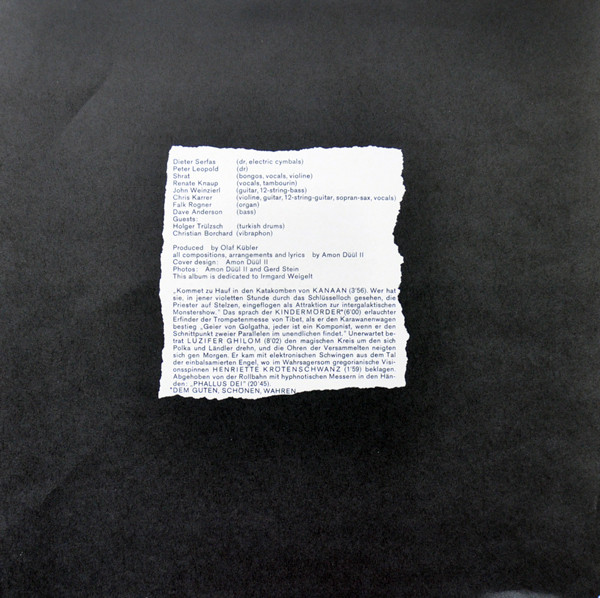


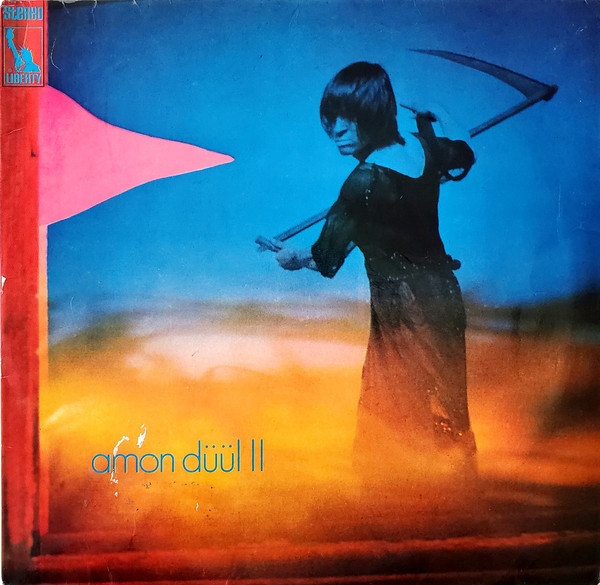






















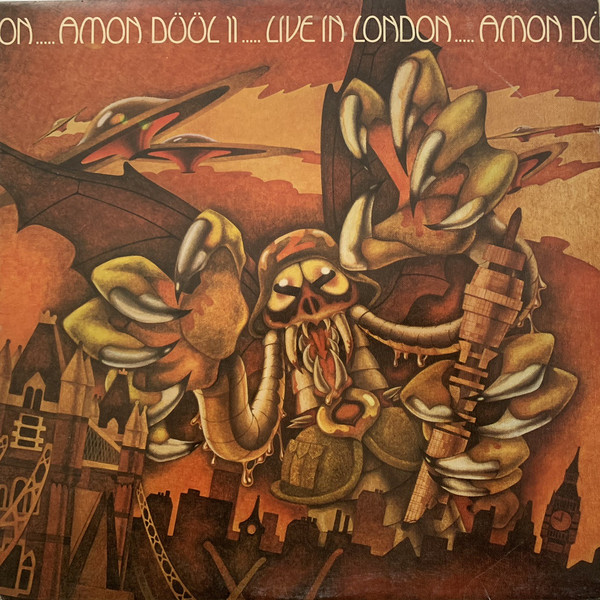
















































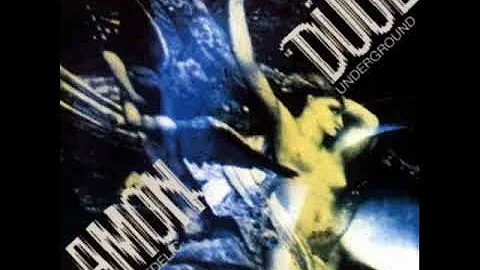























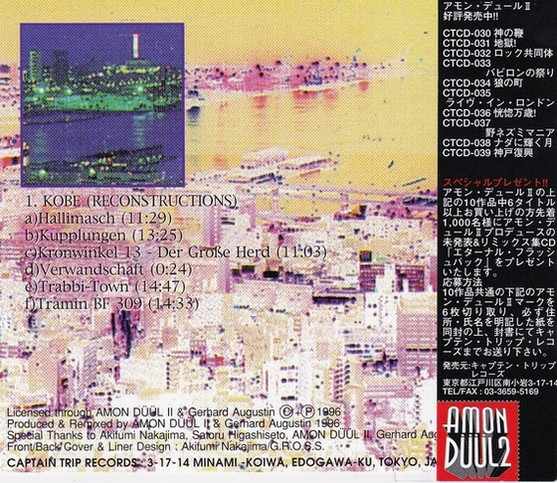









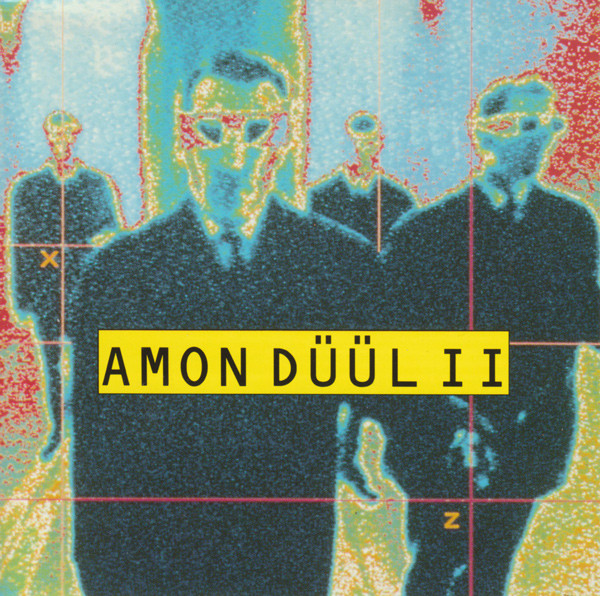


















Nessun commento:
Posta un commento